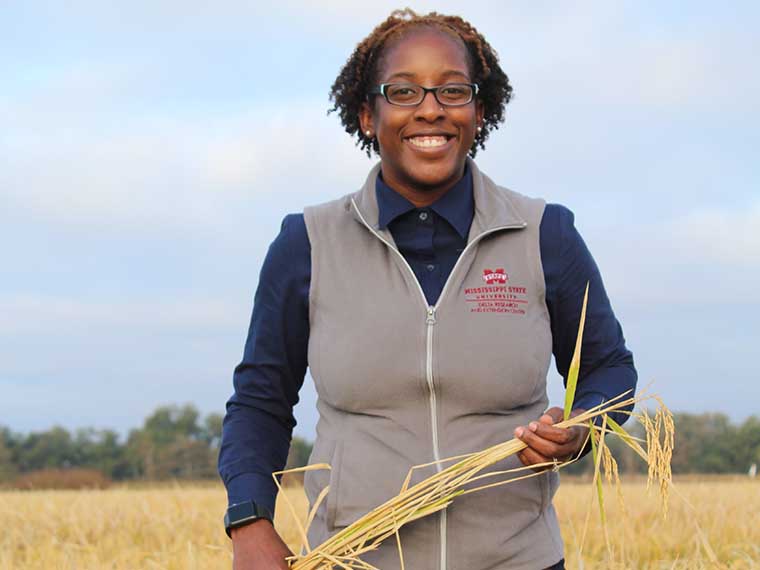The information presented on this page may be dated. It may refer to situations which have changed or people who are no longer affiliated with the university. It is archived as part of Mississippi State University's history.
Greenville, Mississippi native and MSU weed science graduate student Tameka Sanders is working hard to understand the relationship between off-target movement of herbicides and rice development.
Sanders's journey towards studying rice at MSU was a winding one. She earned her undergraduate degree in biology from Delta State University and then began working for the USDA in Stoneville, Mississippi. It was her love of research that eventually led her to a job as a research technician under Dr. Jason Bond, research and extension professor at the Delta Research and Extension Center.
Now as a doctoral student, Sanders's research project is rooted in the work she began as a technician.
"I was already doing the work, so I thought, 'Why not get credit for it?'. Going back for my master's degree and now doctorate was unexpected and unplanned, but learning the science behind the work I was already doing gave me a new perspective and vice versa. Now, I go into my lessons having experienced the material firsthand in my research," Sanders said.
Sanders is studying how rice is affected at various stages of its life cycle by off-target movement of the herbicide paraquat. Off-target movement of herbicides, also referred to as drift, is a phenomenon where herbicides intended for one crop shift, for numerous reasons, onto an adjacent crop, often stunting its growth and development. Sanders is hoping to determine what rice farmers can expect to see from their harvest, in terms of growth and development, if their rice crop has been exposed to paraquat.
She is testing the effects of paraquat on rice at several different stages of the crop's life as well as replicating the tests on different soil textures, all in hopes of charting rice response.
"One aspect of my research focuses on determining the threshold amount of paraquat that can move onto rice before it begins to affect its growth and development. The other aspect is trying to determine what stage of the rice's reproductive growth is the most susceptible to damage from paraquat drift," Sanders said.
An unusually wet harvest season has, however, impacted Sander's ability to retrieve her latest rice yields, putting her data analysis on hold. Once the rice has been harvested, Sanders and her team will carefully weigh out the yield, catalogue grain characteristics, and note overall plant health at the time of harvest. After the data is compiled, Sanders will begin the process of identifying trends and commonalities, and hopefully be well on her way to supplying farmers with an idea of what to expect from paraquat drift.
"I want the work we're doing to be helpful for farmers who are struggling with off-target movement of herbicides. It's a simple goal but an important one. I want to be able to tell farmers what to expect based on the trials we've run here," Sanders said.
This research is supported by the Mississippi Rice Promotion Board.

